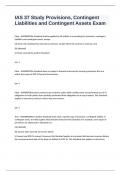Exam (elaborations)
IAS 37 Study Provisions, Contingent Liabilities and Contingent Assets Exam
- Course
- Institution
IAS 37 Study Provisions, Contingent Liabilities and Contingent Assets Exam False - ANSWERSThis Standard shall be applied by all entities in accounting for provisions, contingent liabilities and contingent assets, except: (a) those not resulting from executory contracts, except where the contr...
[Show more]



